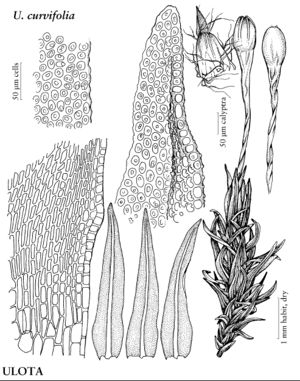Ulota curvifolia
Utkast Sv. Fl. ed. 3, 546. 1816.
Plants to 0.3 cm. Stems erect. Stem-leaves flexuose-crisped and loosely appressed, not contorted or twisted when dry, lanceolate, 1–2.2 mm; base ovate; margins reflexed; apex narrowly obtuse; basal laminal cells linear, grading to quadrate at margin; distal cells 8–12 µm, papillae conic or 2-fid, large. Specialized asexual reproduction absent. Sexual condition autoicous; perichaetial leaves not differentiated from stem-leaves. Seta 1.5–3 mm. Capsule ovate-oblong when mature, oblong to oblong-cylindric when old, 1.2–1.7 mm, strongly 8-ribbed 3/4 length, mouth wide but constricted below mouth or evenly tapering to seta from mouth; stomata in neck; peristome double; exostome teeth reflexed, incurved, smooth; endostome segments 8, smooth. Calyptra conic, very hairy. Spores 16–20 µm.
Habitat: Acidic rock in montane and subarctic areas
Elevation: low to high elevations
Distribution

Greenland, Alta., B.C., Man., Nfld. and Labr., N.W.T., N.S., Nunavut, Ont., Que., Alaska, n Europe, Asia
Discussion
Ulota curvifolia is a Canadian shield species in eastern North America, with a range from the northern shore of Lake Huron and Lake Superior north to Hudson Bay and Baffin Island westward across the subarctic of the Northwest Territories and southward in the Canadian Rockies to Alberta and southern British Columbia. Ulota curvifolia grows on rock and has strongly papillose, thick-walled distal laminal cells and stiffly flexuose leaves. Ulota hutchinsiae has a more southerly distribution, less papillose distal laminal cells, and straight leaves. As with most other species of the genus, U. curvifolia has a rich chestnut brown coloration that helps identify it in the field.
Selected References
None.
Lower Taxa
"/4" is not declared as a valid unit of measurement for this property."wide" is not a number.
